"sterile" and "lifeless"
"Yeah...I'll be glad when T.I. does the whole world a favor by discontinuing all of the "sterile" and "lifeless" sounding LME49xxx buffers.
These were a waste of money for me after listening to them with both the LME4990 and other single op-amps in front of them.
I find it simply hilarious how some people find this combination to sound so good.
This just goes to show that what sounds good to one person may sound like s_it to others.
Trying the LME4990 in other applications(within the feedback loop of other buffers and CF op-amps) also resulted in less-than-stellar SQ for me.
Glad T.I. pulled the plug on this worthless op-amp as well as there are many other single BJT and JFET op-amps that sound so much better from Analog, Linear and other manufactures."
Yes, because you like harmonics and listen to harmonizer amps. The Ti is designed by professionals and it's a good clean amplifier, with exremly low distortion and it's sounding good to me. One only need good headphones and good source material. Here is some measurements to prove my point. The red trace is the source, yellow the amp. Load 33 Ohm s.
"Yeah...I'll be glad when T.I. does the whole world a favor by discontinuing all of the "sterile" and "lifeless" sounding LME49xxx buffers.
These were a waste of money for me after listening to them with both the LME4990 and other single op-amps in front of them.
I find it simply hilarious how some people find this combination to sound so good.
This just goes to show that what sounds good to one person may sound like s_it to others.
Trying the LME4990 in other applications(within the feedback loop of other buffers and CF op-amps) also resulted in less-than-stellar SQ for me.
Glad T.I. pulled the plug on this worthless op-amp as well as there are many other single BJT and JFET op-amps that sound so much better from Analog, Linear and other manufactures."
Yes, because you like harmonics and listen to harmonizer amps. The Ti is designed by professionals and it's a good clean amplifier, with exremly low distortion and it's sounding good to me. One only need good headphones and good source material. Here is some measurements to prove my point. The red trace is the source, yellow the amp. Load 33 Ohm s.
Attachments
-
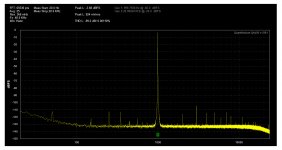 Ti Hp Amp YL 1kHz XMos DAC 33 Ohm.jpg308.4 KB · Views: 492
Ti Hp Amp YL 1kHz XMos DAC 33 Ohm.jpg308.4 KB · Views: 492 -
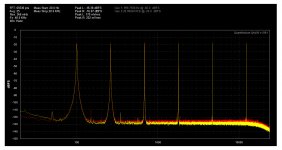 Ti Hp Amp YL Phi6 XMos DAC 33 Ohm.jpg348.1 KB · Views: 486
Ti Hp Amp YL Phi6 XMos DAC 33 Ohm.jpg348.1 KB · Views: 486 -
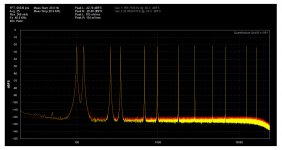 Ti Hp Amp YL Phi12 XMos DAC 33 Ohm.jpg364 KB · Views: 490
Ti Hp Amp YL Phi12 XMos DAC 33 Ohm.jpg364 KB · Views: 490 -
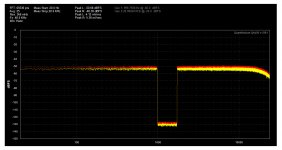 Ti Hp Amp YL White w Notch2 -2dB XMos DAC Rd 33 Ohm - ASUS on Batt.jpg319.7 KB · Views: 473
Ti Hp Amp YL White w Notch2 -2dB XMos DAC Rd 33 Ohm - ASUS on Batt.jpg319.7 KB · Views: 473 -
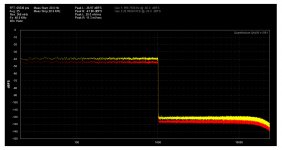 Ti Hp Amp YL LowPass1 XMos DAC Rd ü 33 Ohm.jpg330.4 KB · Views: 437
Ti Hp Amp YL LowPass1 XMos DAC Rd ü 33 Ohm.jpg330.4 KB · Views: 437
Last edited:
ammel68 probably busted out a bit too much moonshineYou know, I heard that is possible to lose sight by drinking poorly distilled liquors but looks like it is also possible to lose hearing
As you can see in most of his posts he really doesn't like integrated circuits and measurements. Nothing wrong with it, not everyone must like accurate music reproduction. Sometimes distortion may be pleasant and seem to sound more natural (eg. tubes). Using an EQ or DSP may be a bit simpler and cheaper than building another amp tho
I had O2 and The Wire, now I'm using Richard Marsh Headphone amplifier which is fully discrete. Both are a great piece of gear, just a bit different. I don't see a point in pushing everywhere your opinion on the one proper way of building amplifiers. Every way is good if builder enjoy the final result - music. And I bet that those ICs won't sound "sterile" and "lifeless" as you say if you try some blind testing. I hope I didn't sound rude, those nuances in English are sometimes a bit tricky for me
LOL...

I've also built and listened to Mr. Marsh's HA, but only as preamp since I don't give a big ole' damn about headphones.
I have to admit it sounds a little better than this so called "Wire" nonsense, but still sucks moose balls compared to the Schiit Magni 3.
Sorry guys... but sometimes DIY just can NOT compete with affordable commercial designs like the Magni 3.

Yes, because you like harmonics and listen to harmonizer amps. The Ti is designed by professionals and it's a good clean amplifier, with exremly low distortion and it's sounding good to me. One only need good headphones and good source material. Here is some measurements to prove my point. The red trace is the source, yellow the amp. Load 33 Ohm s.
Sorry, I have no idea what in the hell "harmonizer amps" are. Do you even know what they are??
Listen...I could give a big ole' $_it less about measurements of the LME-series of buffers.
I've personally listened to them in numerous different applications(mostly line level or preamp) and their sterile SQ simply sucks horse balls.
If you think they sound good, then obviously you've "convinced" yourself that they "should" sound good based on their "low distortion" measurements.
Perhaps one day you'll and others will wake up and understand that measurements and sound quality do NOT go hand in hand.
Unfortunately, there are many members here who are under the misconception that "if it measures better than it must sound better".

Thank you for reinforcing that misconception.
Now...we must bust out the cinammon flavored moonshine and build some "Wires".

Good luck gentlemen.
OK so basically what you are saying Ammel68. This Wire Amp isn't that good at all? Not very nice to say for the designer who has specifically chosen these parts.
Hmm..."basically" is a worthless filler term used far too often today and I'm sick of hearing people use it both on television and on the internet.
I personally don't care about the parts that the designer has chosen or whether you think my comments are "not very nice to say for the designer".
I'm not saying whether the so called "Wire" is good at all, or not. That is quite subjective.
I AM saying I've tried both of the ICs that it uses together, as in the "Wire" as well as in different applications, and have been less than impressed with their results.
There is simply nothing "magical" about either one of these National chips. Use them enough(assuming you can still purchase them) and you'll understand.
The combination of the LME49990 and the LME49610 may have been a "magical" combo WAY back in 2010, but today it's pretty much nothing or else Texas Instruments wouldn't be phasing out the ICs out for it. Go figure.

Now...we must bust out the peanut butter and grape moonshine and build some "Wires".
Sorry, I have no idea what in the hell "harmonizer amps" are. Do you even know what they are??
Listen...I could give a big ole' $_it less about measurements of the LME-series of buffers.
I've personally listened to them in numerous different applications(mostly line level or preamp) and their sterile SQ simply sucks horse balls.
If you think they sound good, then obviously you've "convinced" yourself that they "should" sound good based on their "low distortion" measurements.
Perhaps one day you'll and others will wake up and understand that measurements and sound quality do NOT go hand in hand.
Unfortunately, there are many members here who are under the misconception that "if it measures better than it must sound better".
Thank you for reinforcing that misconception.
Now...we must bust out the cinammon flavored moonshine and build some "Wires".
Good luck gentlemen.
He, you must be a truckdriver.
Alright so from what I'm hearing in the past few comments, the LM chips in question are "too sterile" to be kept in existance? And we shouldn't be too sad that they're going out of production?
I haven't heard the amp myself just yet (in the middle of a buy), but I'm a strong believer of reference gear (Objective DAC -> Objective 2 -> ER4S is my daily work driver), and my understading was that The Wire was meant to be just that - a wire with gain. No subjective difference, no subjective improvements (similar to the Objective 2's principles, sans cost optimisations, DIY-friendly components, etc.).
I agree that there is almost always (note the three different flavors of emphasis on the almost) a difference between better measurements and better sound. However, my audiophiliac goals (and I'm sure the goals of some of the others who own/desire The Wire) are to find gear that is the most sterile and clean (what I would call benchmark, or reference grade) to support the entirety of my setup. Then, I can subjectively understand my tastes (in DAC's, amps, cans, maybe speakers some day) and relate them to the objective measurements of the individual components instead of some system as a whole.
Not everyone has/wants to do this; but there is definitely a niche for this "sterile" and "lifeless" gear...mostly in my audio stack (and sometimes in my pants when I'm really lonely).
I haven't heard the amp myself just yet (in the middle of a buy), but I'm a strong believer of reference gear (Objective DAC -> Objective 2 -> ER4S is my daily work driver), and my understading was that The Wire was meant to be just that - a wire with gain. No subjective difference, no subjective improvements (similar to the Objective 2's principles, sans cost optimisations, DIY-friendly components, etc.).
I agree that there is almost always (note the three different flavors of emphasis on the almost) a difference between better measurements and better sound. However, my audiophiliac goals (and I'm sure the goals of some of the others who own/desire The Wire) are to find gear that is the most sterile and clean (what I would call benchmark, or reference grade) to support the entirety of my setup. Then, I can subjectively understand my tastes (in DAC's, amps, cans, maybe speakers some day) and relate them to the objective measurements of the individual components instead of some system as a whole.
Not everyone has/wants to do this; but there is definitely a niche for this "sterile" and "lifeless" gear...mostly in my audio stack (and sometimes in my pants when I'm really lonely).
Whahaha Murica Am(m)eN68.
It really upsets you he .... Maybe it's better to get some Lays Chips.
Or wait... i guess they must be discontinued either... Tasteless..
What in the hell do "Lays Chips and i guess they must be discontinued either" have to do with anything in this thread or audio in general??
Since you obviously can't contribute anything technically to this thread or to my posts, you decide to post a reply about Lays Chips...SWEEET!
Tasteless?? You're SO funny!

Last edited:
He, you must be a truckdriver.
Apparently English and spelling aren't your strong points, either.
Just FYI, truck driver is TWO words, not one.
BUT...your reply above made me laugh just like this Detectit1 character's reply did!
Congratulations.
Hi Gentlemen,
Can you guys please drop this?
It would be great if an admin could clean up posts 2640 onward as they are off topic, include various members making rude comments to one another, and are generally unproductive.
ammel68:
You are always welcome to your opinion, but this is the third time you have posted essentially the same thing in this thread (see post 2581 and again at 2606), and it serves only to degrade the work that has been done here. If you are looking to pick a fight, please do so in a different thread, or feel free to start your own thread about all the various parts you dislike so passionately.
You've made it clear that you have not heard this specific amplifier, and that you do not care about headphones, so I'm not sure you have much to offer here.
Regards,
Owen
Can you guys please drop this?
It would be great if an admin could clean up posts 2640 onward as they are off topic, include various members making rude comments to one another, and are generally unproductive.
ammel68:
You are always welcome to your opinion, but this is the third time you have posted essentially the same thing in this thread (see post 2581 and again at 2606), and it serves only to degrade the work that has been done here. If you are looking to pick a fight, please do so in a different thread, or feel free to start your own thread about all the various parts you dislike so passionately.
You've made it clear that you have not heard this specific amplifier, and that you do not care about headphones, so I'm not sure you have much to offer here.
Regards,
Owen
@opc - I'm going to try to use this s a preamp going into a stax amp. The Stax amp has an input impedance of 50k.
Would you suggest any modifications/additions put behind a switch when using this in preamp mode into that sort of setup? i am exploring using either a constant gain and then the Stax amp volume pot for control vs the volume pot I already have on my Wire and leaving the stax amp at a reasonable constant gain.
I read online that with speaker amps, you usually want between 20-30 fold difference between the source's output impedance and the sink's input impedance. Can i just leave the stock impedance settings and use this safely + with full sound quality?
Would you suggest any modifications/additions put behind a switch when using this in preamp mode into that sort of setup? i am exploring using either a constant gain and then the Stax amp volume pot for control vs the volume pot I already have on my Wire and leaving the stax amp at a reasonable constant gain.
I read online that with speaker amps, you usually want between 20-30 fold difference between the source's output impedance and the sink's input impedance. Can i just leave the stock impedance settings and use this safely + with full sound quality?
Also adding to the above question ^ I am listening to The Wire right now, and am noticing quite a bit of hum (sounds like AC noise), especially when the RCA on the back of the case are left floating. Any ideas for solutions? I still here the hum but it's much quieter when the RCA are wired to a dac.
Any thuoghts guys?
To summarize: I'm getting a lot of hum out of the amp on low impedance iem's. Occurs at all volume levels, getting louder as I increase volume.
Connecting the RCA out back to a DAC helps, but doesn't eliminate the hum. It feels like a grounding issue but I'm unsure of where it might be coming from.
Any help would be greatly appreciated.
To summarize: I'm getting a lot of hum out of the amp on low impedance iem's. Occurs at all volume levels, getting louder as I increase volume.
Connecting the RCA out back to a DAC helps, but doesn't eliminate the hum. It feels like a grounding issue but I'm unsure of where it might be coming from.
Any help would be greatly appreciated.
Could be a ground loop issue.
Here is a nice article with info to determine or not.
Ground Loops - Eliminating System Hum and Buzz | Audioholics
Here is a nice article with info to determine or not.
Ground Loops - Eliminating System Hum and Buzz | Audioholics
Alright well this would help to isolate the looping issue to the amp alone, am I correct? Ground loops arise when the ground of one component differs from the ground of another, thereby causing a hum defined by the difference between the two grounds?
The hum I'm getting is most prominent with no source attached whatsoever. Amp alone just hums as soon as I power it on. There shuold only be a single signal ground on the amp, which should be the amp's own signal ground. Hence my belief that this isn't a ground loop issue, but something else.
How would the absense of the rework defined here affect the performance of the amp (ie. if I had a rework/initial release board that hadn't been reworked, what would I expect to change compared to a correct board/reworked initial release board): "The Wire" Headphone Amp Build Wiki
The hum I'm getting is most prominent with no source attached whatsoever. Amp alone just hums as soon as I power it on. There shuold only be a single signal ground on the amp, which should be the amp's own signal ground. Hence my belief that this isn't a ground loop issue, but something else.
How would the absense of the rework defined here affect the performance of the amp (ie. if I had a rework/initial release board that hadn't been reworked, what would I expect to change compared to a correct board/reworked initial release board): "The Wire" Headphone Amp Build Wiki
Should I only expect optimal performance for a certain range of impedances? Or does is drive everything from sensitive IEM's to planar magnetics with the same quality?
I would like to know as well.
According to my friend, the "ability to drive down to 4 ohms with no load dependance" literally means the ability to drive sensitive headphones -- including BA-based in-ear-monitors -- without any hint of noise. He said if a built does not drive all in-ear-monitors -- and he has a few -- with a totally black ground, then it is no good.
Let's avoid the he - said she - said game here. My build I have purchased significantly hums with sensitive (anything less than or equal to 32ohms) gear, IEM's especially (since those are what I own that are more sensitive). Significant hum means that I cannot "drown out" the humming noise unless I crank my music to deafening levels, which are extremely unhealthy for listening. Other than that I can hear the noise loud enough on top of the music I'm playing.
With a heavier load (Mr. Speakers Alpha Prime, or an external amp plugged into the headphone out) I get almost no audible hum. It barely exists, but is drowned out by the audio
From what I understand about The Wire - and the numbers I've seen on The measurements - I should be hearing nothing at all, on both heavy loads and sensitive loads (greater than 8ohms at least) since the noise should be far below the audible range (at least -100db). Please correct me if in wrong.
With a heavier load (Mr. Speakers Alpha Prime, or an external amp plugged into the headphone out) I get almost no audible hum. It barely exists, but is drowned out by the audio
From what I understand about The Wire - and the numbers I've seen on The measurements - I should be hearing nothing at all, on both heavy loads and sensitive loads (greater than 8ohms at least) since the noise should be far below the audible range (at least -100db). Please correct me if in wrong.
Last edited:
I have a SE to SE version of the Wire. I have had it since the 1st version of the WIRE came out. I am using an external +/-15 volt, fet, series regulated power supply that I bought on ebay as a kit a few years ago. I use the head phone amp as a preamp with a voltage gain of 3x. The wire is powered on 24 hours a day. I listen to it almost every day. With my Sennheiser 598 head phones and the volume control at any position and all inputs disconnected I cannot hear any type of noise or hum with the wire powered on or off. There is absolutely no hum or hiss at all that I can hear. If you can hear hum or any type of noise you have a wiring problem, a grounding problem, a soldering problem, a component problem or perhaps a power supply problem. Try hooking the wire up with 2 nine volt batteries. If the hum goes away it may help you to isolate your issues. Is the hum 50/60 hz or 100/120hz?
The buffer chips in the wire can output 250 ma before current limiting cuts in. You can drive speakers with the wire headphone amp directly without danger of destroying the chips. I've done it. In fact I also have the wire's bigger brother, the wire power amp, 8 chips in parallel.
The buffer chips in the wire can output 250 ma before current limiting cuts in. You can drive speakers with the wire headphone amp directly without danger of destroying the chips. I've done it. In fact I also have the wire's bigger brother, the wire power amp, 8 chips in parallel.
Is the hum 50/60 hz or 100/120hz?
The noise in 120hz (just checked against a generated tone on my phone). I've taken the amp apart. Here are some pictures.
The wire - Google Drive
It makes a little more hum every time I physically come in contact to the volume knob or heat sink or transformer. The build quality looks ok to me - PSU is running at +/-15v dc output. I will check the noise riding on the PSU DC output tomorrow with an oscilloscope if I can.
Is there anything in the build quality that leads you to think there might be a problem? I don't see anything jumping out at me.
Brown wires go to headphone out. White seems to be signal in and red/grey seem to be AC power from the wall. I've tried multiple outlets at home and work so I'm certain that it's not just my AC power input that's really REALLY noisy - it should be fairly clean.
C32,C27,C23,C30 look a little suspect. I cant tell if they are actually soldered or cold solder joints or touching a nearby pad. More hum when touching a part usually means the part is not grounded. The shaft of the volume control is usually grounded through the metal case and there should be no hum when touching it. When you turn the Wire off is there a few seconds of silence before the filter capacitors discharge? Is the output voltage of the Wire buffer chips very close to 0 volts, within a few millivolts. Put your meter on the millivolt AC scale and measure the outputs of the power supply, again should be near 0Volts AC. Also check the AC power supply output voltage with different loads should be the same ie near 0VAC
- Home
- Amplifiers
- Headphone Systems
- "The Wire" Ultra-High Performance Headphone Amplifier - PCB's